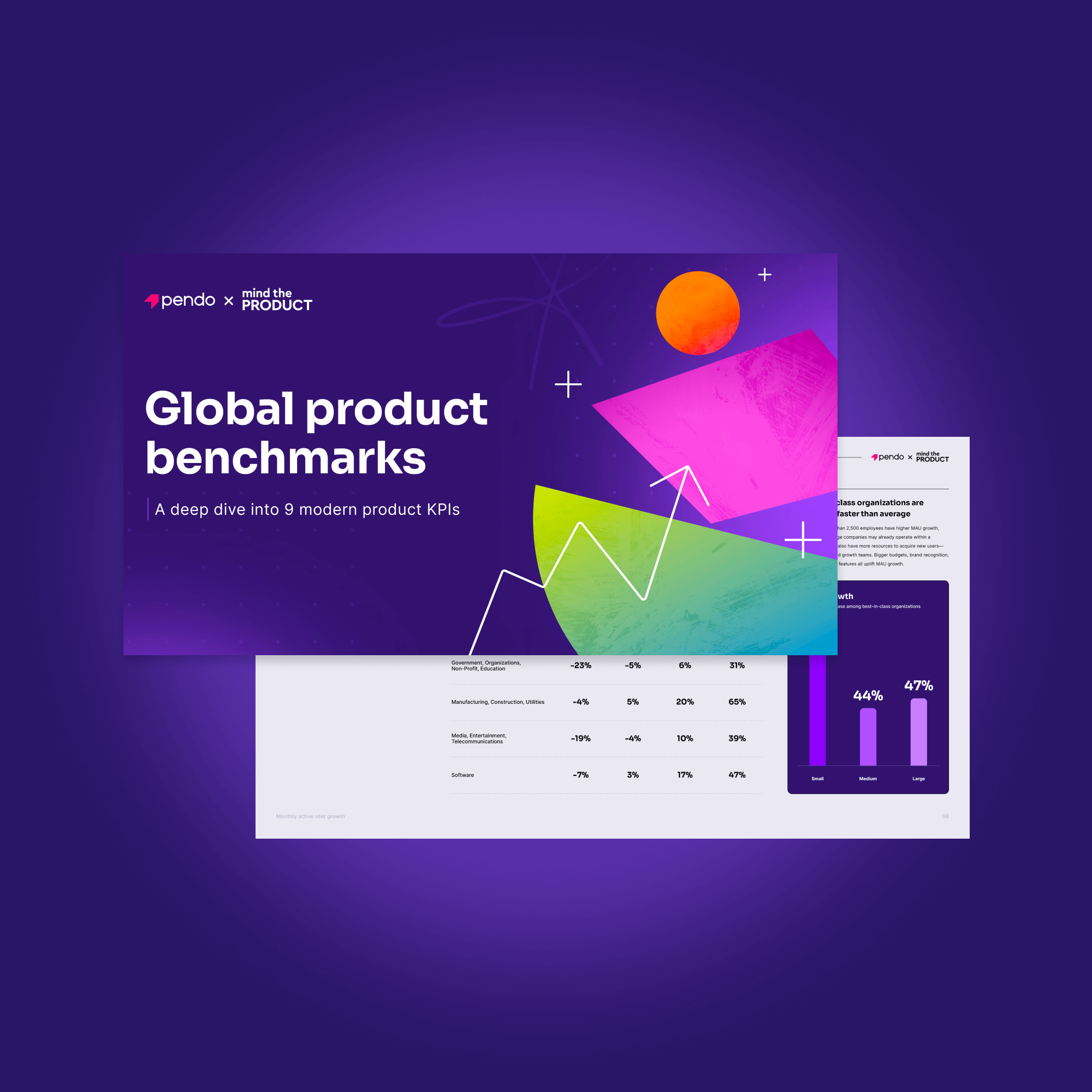
目次
お急ぎですか?
PDFをダウンロードして後で見る
プロダクトとビジネスの成功を促進するための実証済みの指標
はじめに:プロダクトリーダーシップにおける現代の課題と機会
プロダクトや会社の成功を測定することの意味
確かに、常に頼りにできる主軸はいくつかあります。プロダクトのアクティブユーザー数を増やし、プロダクトの定着率とリテンションを高めることは、継続的にビジネスを成功させるための基本です。
しかし、最近は少し状況が異なります。たとえば、Gartnerは2025年までに75%の企業がAIを運用化すると予測しています。AIは現代の企業の業務を急速に変化させており、これらの企業の多くは、成功を測定する方法を理解するためにリアルタイムで取り組んでいます。その間にも、仕事とリーダーシップのプラクティスは変化しています。自動化、バイブコーディング、ユーザーインテリジェンスは氷山の一角にすぎません。
2025年においてプロダクトリーダーになるためには、技術的な流暢さと戦略的ビジョンの間で慎重にバランスを取り、外部の雑音を明確にすることが求められます。新しいテクノロジーや新しいやり方によって、プロダクトリーダーは、今がプロダクトを成功に導くための非常にエキサイティングな時期であることを認識しています。
このガイドでは、過去1年間に14,000人以上の顧客と仕事をしてきた経験を基に、すべてのプロダクトリーダーが知っておくべき10のKPIについて説明します。私たちは主に、すべてのプロダクトチームにとって重要なKPIと考えられるものにこだわっていますが、AIがどのように状況を変えるかについても掘り下げています。
プロダクトの成功を測定するための必須事項を理解する
視野を広げて、さまざまな種類のKPIを大まかに理解しましょう。覚えておくべき3つのカテゴリーは次のとおりです。
- ビジネスの成果:最も重要なビジネスの成果は何ですか。また、プロダクトは短期的、長期的に主要なビジネスと財務の成果にどのように影響しますか。これらは、解約の削減、長期的なユーザーリテンションの向上、または新規ユーザーや購読者の獲得と密接に関連している可能性があります。
- プロダクトの使用状況:これらのKPIはユーザーがプロダクト内でどのように行動するかを反映します。ユーザーが最も使用しているのはどのフィーチャーですか。ユーザーはどこで行き詰まっていますか。これらの指標は、ユーザーがどのようにソフトウェアに価値を見出すか、または見出さないかを理解するために重要です。
- プロダクトのパフォーマンス:これらのKPIは、プロダクトが意図したとおりに機能しているかを測定します。プロダクトの応答時間や先月のダウンタイムはどれくらいか。社内で品質指標のベンチマークを設定し、月次または四半期ごとに測定することをお勧めします。
2025年に重要な10のKPI
重要なKPIを選定する際、コスト、機能の定着率、ユーザーのセンチメントなど、プロダクトリーダーがアプリの重要な側面を追跡するのに役立つ指標を考慮しました。これらの指標は、イノベーションと安定性の両方の要求に応え、ユーザーがソフトウェアをどのように利用しているかを理解するのに役立ちます。これにより、解約を低減させると同時に、ユーザーが将来何を望んでいるかについての重要なインサイトを得ることができます。
1. 予測顧客生涯価値(CLTV)
新規顧客を獲得するコストは既存顧客を維持するコストよりもはるかに高いことは周知の事実です。そのため、長期的な顧客の生涯価値を理解することは重要です。
過去の平均に依存する従来のCLTVモデルでは、AIによる行動の変化やサプライチェーンの混乱といった動的な変数をうまく考慮することができません。より競争力のある企業は、現在の意思決定が将来の収益にどのように影響を与えるかを理解するために、AIを活用した予測モデルに目を向けています。
予測CLTVは機械学習を統合して、ユーザーインタラクションパターン、マクロ経済の傾向、地政学的イベントなどのリアルタイムデータストリームを分析します。それらには取引データ、ユーザー行動指標、機能やプロダクトの設定を利用することができます。
たとえば、B2Bソフトウェアプロバイダーは、予測CLTVを使用して、規制が変化すると成長機会が生まれるヘルスケアや再生可能エネルギーなどの将来性の高い業種にリソースを割り当てることができます。
CLTVが重要な理由
予測CLTVは、プロダクト全体の価値をより深く理解するために不可欠であり、機械学習を活用してより正確な価値の見積もりを提供します。さらに、ユーザーが新しい機能、特にAIを基盤にした機能をどのように導入するかをより深く理解するのに役立ちます。
CLTVを測定する方法
CLTVの計算は簡単です。顧客の年間価値に顧客の平均生涯期間(契約またはライセンスの年数)を掛け合わせ、獲得コストやメンテナンスコスト(一般的な顧客獲得コスト、価値実現までのコスト、その他の指標など)を差し引きます。

2. AI機能の定着率
機能の定着率は本質的にユーザーアクティベーションの指標であり、AIプロダクトの機能の定着率は、AIプロダクトがユーザーにもたらす即時かつ継続的な価値を明確に示しています。
このKPIでは、チャットボット、自動レポート、予測アナリティクスなどのAI機能にユーザーがどれだけ深く関与しているかを測定します。定着率が低い場合、ユーザーのニーズと機能設計の間にずれがある可能性を示しています。たとえば、CRMプラットフォームで、教育不足のためにAIによる売上予測が十分に活用されていないことが発見され、アプリ内オンボーディング体験の再設計が促されることがあります。
ユーザーベースがAI機能に対してどのように関与しているかをチームが理解すれば、ユーザーをより適切にサポートし、AI機能の継続的な定着化を促進できます。
AI機能の定着率が重要な理由
AIの定着率を追跡することで、投資のROIを確保できます。定着率が低い場合は、機能設計のずれやオンボーディングの不十分さを示しています。一方、定着率が高い場合は、リテンションや収益の成長と相関しています。チャットボットや予測アナリティクスを用いてエンゲージメントを測定することは、チームがユーザー体験を洗練させ、AI開発コストを正当化するのに役立ちます。
AI機能の定着率を測定する方法
定着率は、機能にアクセスできるユーザーベース全体に対する割合として表されます。

機能の定着率を高める方法
定着率を測定する主要な利点の1つは、顧客に利益をもたらす機能に誘導する方法を把握できることで、それによってプロダクトへの関与を維持しやすくなります。主要機能の定着率を向上させるには、プロダクト自体の中で行うのが最も効果的です。機能の定着率を向上させるためのアプリ内戦術には以下のものがあります。
- アプリ内メッセージを使用して新機能を知らせる。
- アプリ内ウォークスルーを使用して、ユーザーを特定の機能に案内し、オンボーディングを支援する。
- セグメントを使用して、その機能に価値を見出す顧客へのコミュニケーションをターゲットにする。
実例のご紹介:Okta
ユーザー体験を測定するには、ユーザーベースを詳細に理解することが必要です。Oktaは、既存の顧客体験を理解し、改善の機会を特定するのにPendoが役立つことを発見しました。
「自由に使えるデータに基づいて、チャネル間でユーザーのセグメント化やターゲット化、再ターゲット化ができるため、Oktaの設定に必要な重要な事柄について効果的に指導、誘導できます」
Okta デジタル体験ディレクター Tom Witczak氏
3. ユーザーの成長率
成長は、組織の健全性にとって最も重要な指標かもしれません。成長はブランドのアウトリーチ活動を反映していると考えます。新しいユーザーをどれだけ効果的に惹きつけていますか?既存のユーザーベースでの利用拡大の取り組みはどの程度の効果がありますか?
ユーザーの成長率が重要な理由
古いことわざにあるように、成長しなければ死んだも同然です。成長指標の変化は、チームがアウトリーチ、ユーザー体験、その他の懸念事項に関する問題を特定するのに役立ちます。「成長」そのものはカテゴリーによって異なりますが、ソフトウェアプラットフォームの場合、成長はユーザーベースの拡大、そしてそれに続く収益の増大に直結します。
とはいえ、ユーザーがプラットフォームでどれだけの時間を使ったか、あるいは特定の機能を使ったかなど、他の要因に基づいて成長を測定することもできます。
ユーザーの成長率を経時的に測定する
ユーザーの成長率を測定する鍵は、時間の本質的な尺度を理解することです。ほとんどのサブスクリプションベースのソフトウェアプラットフォームにとって最も重要な時間枠は、月と年です。より具体的には、月次、年次のユーザーの成長を測定します。
月間アクティブユーザー(MAU)の成長を測定するための計算式は、期間によって異なることがあります。たとえば、ある月から次の月までの成長を測定するには、その期間の成長率を算出することを意味します。

これは、成長をパーセンテージで表現する方法です。より長い期間を測定するには、この式を拡張するだけです。たとえば、年初から年末までの成長を測定する場合、式は次のようになります:

5. プロダクトエンゲージメントスコア(PES)
PESは、プロダクト全体の健康状態を示す包括的な指標です。この指標は、粘着率、定着率、成長を測定する指標を組み合わせています。PESは一目で状況を把握するためのツールですが、含まれる指標を深く掘り下げて問題点を特定し、修正することができます。
PESが重要な理由
PESは、ユーザーがプロダクトや機能をどのように導入し、長期間にわたって使い続けるかを示す指針です。また、プロダクトや機能のパフォーマンスを把握するための優れた「全体像」としても役立ち、個々のKPIをより深く理解するためにどこから掘り下げるべきかを示してくれます。
PESの測定方法
PESは、粘着率、定着率、成長率の複合指標です。定着率、粘着率、成長率の値が算出できたら、単純に3つの数値の平均に100を掛けることでPESを計算できます。

PESは、訪問者またはアカウントを選択し、それに基づいて測定できます。もし、プロダクトがチームではなく個人によってのみ使用されるのであれば、PESの各要素は訪問者レベルでのみ測定することになるでしょう。新規企業顧客の獲得に注力している会社であれば、アカウントレベルでの成長率(さらにPES全体)を測定することで、取り組みが最もよく反映されます。選択に迷う場合は、組織の現在の重要優先事項に合わせてPESを設定するようにしましょう。
PESの向上 = ビジネス成果の向上
PendoのデータサイエンスチームはPESのみを使用して顧客の解約率、使用率、成長率を予測するという課題に挑戦しました。契約終了前の数か月間でPESが高いアカウントは更新される可能性が高く、PESが低いアカウントは解約と相関していることが判明しました。わずか6か月間のPESスコアで、更新についての信頼できる指標が作成されました。
5. 価値実現までの時間(TTV:Time to value)
競争の激しい市場では、ユーザーは即時のROIを期待します。TTVでは、BIツールでデータ分析を完了、DevOpsプラットフォームを通じてコードをデプロイするなど、価値を示す重要なアクションである最初の「コアイベント」をユーザーがどれだけ早く達成するかを測定します。TTVが遅いと、離脱率が高くなることが多いです。たとえば、ノーコードのウェブデザインプラットフォームでは、テンプレート化されたワークフローを通じてユーザーをガイドし、数分以内にランディングページをリリースすることで、TTVを短縮できます。
TTVを検討する際に考慮すべき主要なコンポーネントは以下の通りです。
- ユーザーオンボーディングの効率:ユーザーはどのくらい早くプロダクトを効果的に操作できるか。
- 最初の意味のある成果:ユーザーが最初の基本的なタスク(レポートの作成、ミーティングのスケジューリングなど)を完了するのはいつか。
- 完全な価値の実現:ユーザーがプロジェクト、成果物、または成果を完全に実現するためにどのようなプロセスを経る必要があるか。
価値実現までの時間が重要な理由
ユーザーはできるだけ早く価値にアクセスすることを求めています。オンボーディングを合理化してTTVを短縮することで、特に競合が多いSaaS市場において、離脱率を減らし、競争上の差別化を推進できます。
TTVの測定方法
TTVを計算する一般的な公式はありません。この指標を理解するには、提供「価値」(機能の使用、特定のプロセスやプラクティスの展開など)と測定の開始点(最初の登録、最初のログイン、または他のマイルストーン)を明確に定義する必要があります。これらの基準に基づくと、TTVは日、分、さらには秒で表現するのが最適な場合もあります。
6. プロダクトのパフォーマンス
パフォーマンス問題に対するユーザーの許容範囲は急落しており、1秒の遅延でも信頼が損なわれる可能性があります。このKPIは、ベンチマーク(アップタイムが99.9%、重要なアクションのロード時間が2秒未満など)を用いて、アップタイムと応答性を定量化します。たとえば、eコマースプラットフォームでトラフィックのピーク時にチェックアウトの遅延が発生すると、カゴ落ちや評判の低下のリスクがあります。
理解しておくべき重要なパフォーマンス指標には以下のものがあります。
- システムの平均アップタイム
- ページ読み込み時間
- ユーザーチケットの応答時間
- ユーザー満足度スコア
プロダクトのパフォーマンスが重要な理由
2025年においてパフォーマンス指標(アップタイム、応答時間)は交渉の余地なく、必須のものになります。1秒の遅延はコンバージョン率を7%低下させる可能性があるため、ほぼ即時の読み込み時間と99.9%のアップタイムはユーザーを維持するために不可欠です。これは、eコマースやフィンテックなどの分野で特に当てはまります。
プロダクトをどのようにスタックしていますか?
プロダクト性能ベンチマークは単独で存在するものではありません。プロダクト性能ベンチマークは、他の社内指標や業界内の同業者のデータと比較することで最もよく理解できます。これを念頭に、Pendoは2,500社の顧客から6,800を超えるアプリケーションのデータを収集し、チームが地域、企業規模、業種に基づいてプロダクトをベンチマークできるようにしました。インタラクティブなベンチマークで自社のプロダクトの位置を確認してください。
7. パーソナライズによる収益の向上
このKPIは、ダイナミックプライシングやパーソナライズされたコンテンツの推奨など、パーソナライズされた体験による収益向上を測定します。例えば、AIを活用してコース提案をカスタマイズするeラーニングプラットフォームでは、修了率やサブスクリプションの更新率が向上する可能性があります。
パーソナライゼーションをROIの関数として決定することは、パーソナライゼーションによる増分利益を収益の増加とコスト効率に直接結びつけることを意味します。このアプローチには、次のような方法が含まれます:
- ユーザーの利用とリテンションに関連する主要な指標を特定します。指標には機能の定着率、生涯価値、解約などがあります。これらの基準を用いてベースラインを確立することが重要です。
- パーソナライズアプローチを指標とリンクさせます。生成AIを使用してアプリ内メッセージを作成、行動分析を追跡して主要な機能を操作するユーザーにタイムリーなサポートを提供します。
- A/Bテストの実験を行います。特定のパーソナライズタスクをポジティブなビジネス成果に結びつけます。
パーソナライズによるROIが重要な理由
AIを活用した高度なパーソナライズはエンゲージメントを高めますが、関連する費用を正当化するには測定が必要です。カスタマイズされた体験(ダイナミックプライシングなど)による収益の向上を測定することで、取り組みがビジネス成果と一致していることを確認できます。
実例のご紹介:Alarm.com
Alarm.comは、カスタマイズされたガイドとサポート機能を使用して、カスタマーサービス担当者がユーザーのニーズに確実に応えられるようにしたいと考えていました。同社はPendoアナリティクスでパスとファネルを使用して顧客の考えや感情をより深く理解し、顧客固有のニーズに合わせてコンテンツを調整できました。
「これは、サポートセンターの立ち上げ時に、エージェントの業務と全体的なセンチメントに大きな影響を与えました。また、同様に重要なのは、OJTのリソースを作成することで非同期トレーニングの開発に費やす時間を大幅に削減できるため、規模の拡大が可能になったことです。」
Alarm.com カスタマーオペレーション部門システムマネージャー Mary Kidd氏
8. 予測解約率
解約は依然として重要な指標ですが、予測モデルによって解約リスクがあるユーザーが離脱する前に特定されるようになりました。MLモデルでは、エンゲージメントの低下、支払い履歴、センチメントの傾向を分析して、解約リスクスコア(0~100)を割り当てます。たとえば、ストリーミングサービスの場合、値上げ後に視聴時間が減ったユーザーにフラグを立て、ターゲットを絞ったリテンションオファーを提供することがあります。
予測解約率が重要な理由
予測モデルは、エンゲージメントの低下と支払い傾向を分析し、解約リスクがあるユーザーを離脱前に特定します。積極的なリテンション戦略(ターゲットを絞ったオファーなど)によって、サブスクリプションベースのモデルにおける顧客離れを減らし、収益を確保します。
予測解約率の測定方法
従来、解約率は次の式で表現できます。

しかし、予測解約率はより将来を見据えたものです。アナリティクスと月次トレンドを活用して、今後数か月の潜在的な解約を判断することを意味します。機械学習とAIにより、より深い分析を提供できます。
9. ネットプロモータースコア(NPS)
ユーザーはあなたのブランドを推奨してくれますか?そうでない場合は、NPSを使用して、プロダクトに関する体験についてユーザーのセンチメントを把握することができます。
通常、NPSは、ユーザーや顧客を調査によって収集し、回答に基づいて「推奨者」と「批判者」に分け、その比率で関係を表現します。
これらのスコアでユーザーの心と考えを垣間見ることができます。特にスコアがソフトウェアで直接収集された場合に有効です。回答は状況に即しており、かつタイムリーであるため、受け身ではなく積極的に問題に対処する方法が提供されます。これにより、NPSは顧客の不満や体験に対する早期の警告システムとして特に役に立ちます。
フィードバックループにおいてNPSが重要な理由
顧客のセンチメントを理解することは常に価値があります。NPSを継続的に追跡することで、顧客が現在、将来どのように支持してくれるかを把握するのに役立ちます。しかし、NPSは定性的な指標であるため、プロダクトの使用状況などの定量的データと組み合わせて使用することで最も効果的に機能します。
実例のご紹介:Cision
Cisionは、新規顧客がブランドについてどのように感じているか、特に、異なる顧客行動からどのようにしてNPSスコアが上昇したかを知りたいと考えていました。Pendoを使用して、ターゲットを絞ったNPS調査を実施し、顧客にブランドを推奨させる可能性が高い指標を特定しました。
「アカウントレベルのデータまで取得できることは、私たちにとって大きな差別化要因です。他のアナリティクスツールでは、このようなことはできません。」
Cision カスタマーサクセス担当副社長 Becky Banasik氏
10. Feedbackから機能への速度
このKPIは、チームがどれだけ迅速にユーザーからのインプットをプロダクト改善に反映させるかを測定します。たとえば、プロジェクト管理ツールの場合は、パワーユーザーからの機能リクエストを優先し、四半期単位のスプリントで更新をリリースすることがあります。
フィードバックから機能への速度が重要な理由
プラットフォームまたはプロダクトは、SaaS開発モデルを使用して継続的に開発されています。これは、ソフトウェアの制限に対処し、確立された(理想的にはロイヤルティの高い)ユーザーベースのニーズを満たすプロダクトを提供するために、ユーザーフィードバックが重要であることを意味します。
フィードバックから機能への速度を測定する方法
この指標は、最初のユーザーフィードバックやアルファ版のレビューから、そのフィードバックに関連する機能が実装されるまで平均期間として表現されます。コメントやフィードバックのプラットフォームを活用して、フィードバックループがどのように段階的な変化をもたらすかを確認し、直接または間接的なユーザーフィードバックをもとに開発された本番環境の機能の数を記録できます。
実例のご紹介:Filevine
リーガルプラットフォームのFilevineは、開発サイクル内に機能のローリングアップデートを組み込む必要があることを社内で決定していました。顧客フィードバックに基づいた長期的なロードマップを維持しながら、ソフトウェアの開発を続ける必要がありました。このロードマップでは、業界の要求を反映しつつ、規制の遵守も確実に行う必要がありました。FilevineはPendo Feedbackを使用して、ターゲットを絞ったコンテキスト内のフィードバックリクエストを通じてユーザーの回答を収集しました。
「Pendoの行動分析とアプリ内ガイダンスをPendo Feedbackと組み合わせて使うことで、完璧なパッケージになりました。フィードバックと同時に使用状況も把握できるのは、重要なポイントでした。」
Filevine プロダクトフィードバック担当ディレクター Mary Lyon氏
永続的なKPI
上記で取り上げたAIを活用したKPIの測定、分析、改善に着手する一方で、すでに確立された(そして依然として関連性のある)KPIをおろそかにしてはいけません。ここでは、決して時代遅れにならない3つのKPIを紹介します。
売上維持率(NRR)
売上維持率(NRR)は、継続的な収益の維持を支えるため、サブスクリプションベースのビジネスにとって依然として重要な基盤です。McKinseyによると、NRRが120%以上の企業は、新規顧客を獲得しなくても年間20%の成長が見込めます。
NRRは拡大と解約の差です。NRRは一般的に100%を超える値が期待されています。一部の顧客を失うことだけでなく、維持している顧客の価値を拡大する方法を見つけることも想定されています。
NRRの測定方法
先ほど説明したとおり、NRRは拡大率から解約率を差し引くことで測定できます。これには4つの値が必要です。
- 前月の月次経常収益
- アップセルとクロスセルによる収益
- ダウンセルによる損益
- 解約による損益

多くの企業ではNRRを月次または年次で追跡していますが、変動があった場合に迅速に対応するために、月次でNRRを確認することをお勧めします。
アダプション(定着化)
定着率の指標はプロダクトと市場の適合性を検証しますが、現在では一般的なプロダクトの使用とAIを活用した機能に対するエンゲージメントを区別するためのきめ細かさが求められています。2025年には、プロダクトは差別化を図るために、自動化されたワークフローや予測アナリティクスなどの組み込みAIツールにますます依存するようになるでしょう。Accentureによると、経営幹部の97%がこの動きを業界にとっての変革と見なしています。
リーダーは、全体的な定着率と、ユーザーがさまざまな機能をどのように利用しているかを追跡する必要があります。たとえば、プロジェクト管理プラットフォームは、AIを活用したタスク優先順位付け機能の週別アクティブユーザー数(WAU)を監視し、このデータをプレミアム層のアップセル率と相関させることがあります。
定着率の測定方法
プロダクトの定着率は、月別アクティブユーザー数(MAU)、週別アクティブユーザー数(WAU)、日別アクティブユーザー数(DAU)で時系列に表すことができます。また、プロダクトの定着率を一定期間の新規ユーザー登録数に対する割合で測定することもできます。プロダクトの定着率をどのように測定するかは、プロダクトのアクティブユーザーというものが何を意味しているかに大きく依存します。お客様が毎日アクセスするようなソフトウェアであれば、DAU指標で測定するのが最も理にかなっているでしょう。
粘着性
粘着率(プロダクトが習慣的に使用されているかを示す指標)は、毎日のログイン数を追跡するだけにとどまりません。パーソナライズされたレコメンデーションや予測インサイトなどのAI機能により、アプリ内でのユーザーエンゲージメントが深まっています。たとえば、AIを活用して支出の習慣を予測するフィンテックアプリの場合、ユーザーが予算予測を毎日確認する可能性があり、リテンションに直接影響します。
最新の粘着性指標は、AIを活用したエンゲージメントを分離し、これらの機能を導入したユーザーと従来の機能に依存するユーザーの間で、リテンション率を比較する必要があります。
粘着性の測定方法
粘着率は、特定の時点でのアクティブユーザー数と一定期間内でのアクティブユーザー数の比率として表されます。たとえば、DAUとMAUを使用して、特定の日のソフトウェアの粘着率を確認できます。

強化された重要なKPI
AIは、プロダクトリーダーがKPIを追跡し解釈する方法を変革し、プロダクトの成功をこれまで以上に測定可能、予測可能、実行可能なものにしています。リアルタイムのユーザーインサイトから自動化したトレンド分析にいたるまで、AIを活用した分析により、プロダクトマネージャーは静的なダッシュボードを超えて、動的で適応力のある意思決定を行うことができます。
AIが進化し続ける中、その能力をKPIのフレームワークに組み込むことで、大きな競争力を得ることができ、プロダクトが現在の市場の需要を満たし、将来のトレンドを予測することが可能になります。
Pendoは、このガイド全体で説明されているKPIについて、企業が測定し、改善するのを支援します。プロダクトアナリティクスとリプレイデータを使用してユーザーの行動を理解し、摩擦を発見し、AIを活用した分析を使用して傾向を特定します。この定量的データを定性的なフィードバックと組み合わせることで、チームは顧客体験の全体像を把握できます。その後、ノーコードのアプリ内ガイドを使用して簡単にアクションを起こし、プロダクトの定着化を促進し、ユーザーエンゲージメントを高め、収益を増加させることができます。
Pendoが主要なプロダクトKPIの測定と対応にどのように役立つかをご紹介します。今すぐパーソナライズされたデモをご依頼ください。


